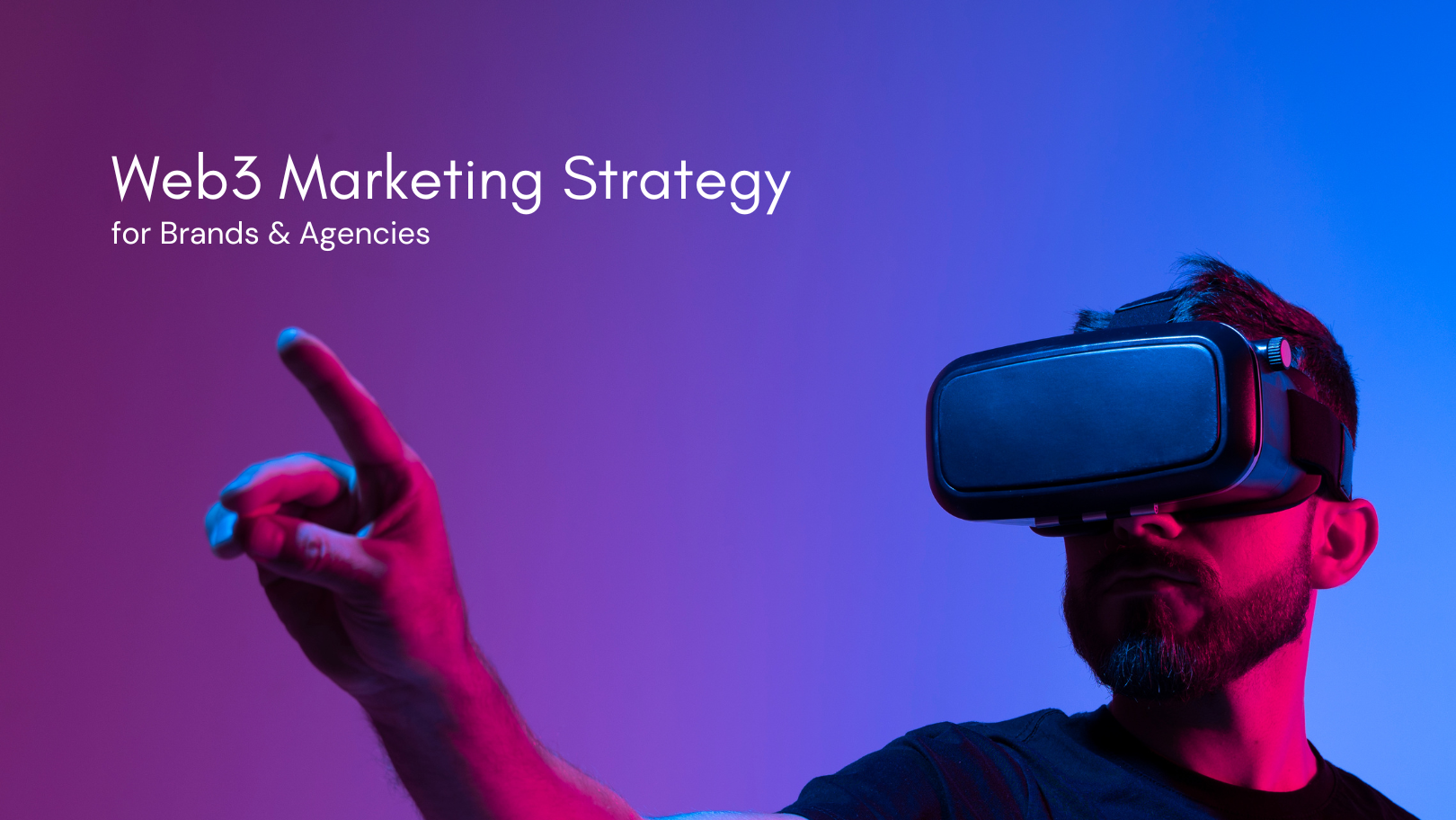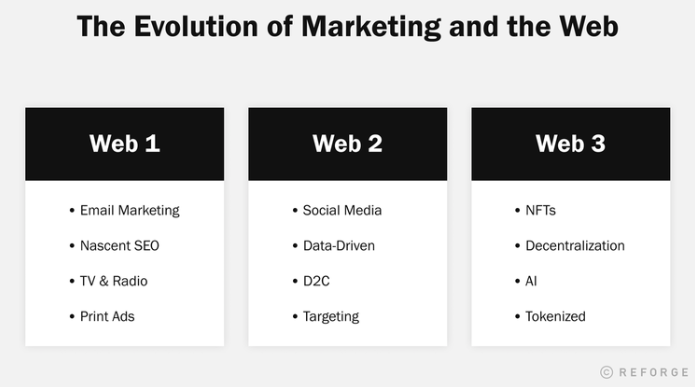Imagine a new type of Internet that understands precisely everything you type and what you ask it to, whether by text, voice, or otherwise, in which all the content you consume is adapted for you more than ever before. Now we are at the turning point of a new stage in the evolution of the Internet, called Web3. How will it transform digital marketing? What does Web3 mean for brands and agencies? What Web3 marketing strategy to choose for your business? This post will answer these questions and discover the marketing transformations it brings.
What is Web3 Marketing?
Web 3.0 (also Web3) is the upcoming third generation of the Internet involving semantic web technology and artificial intelligence. The technology focuses on creating a more autonomous, intellectual, and open Internet.
The evolution of Internet technologies cannot bypass marketing. Though the idea of moving to a “decentralized” Internet may seem far away, it is not so. Marketers are already preparing for this transition by getting acquainted with the unique features and benefits of Web3 technologies.
Web3 marketing is a concept that explores the web by looking at trends and revolutionizing technologies. It is more than just websites and SEO. With Web3, marketers can boost the user experience by providing rich and interactive advertising opportunities. In addition, Web3 blockchain technologies, transparency, and data privacy will completely change the digital marketing industry.
Let’s look at marketing in Web 1.0 and Web 2.0 times to feel the difference. Originally there were very few content creators, and personal pages consisted of static pages hosted by paid web servers or free web hosting services. Marketers relied on email marketing and used online messaging to enhance the effect of traditional ads via TV, radio, and print.
Marketing in Web 2.0 is all about consumer-first, data-driven, and mobile-first Internet. Moreover, the growth and popularity of social media channels have helped bring targeted ads. Digital marketing has become analytics-oriented, and brands have begun to understand their audiences better. Web2 marketing is about interest-based advertising, influence marketing, direct-to-consumer brands, improved SEO tactics, and more.
The key innovation of Web3 marketing is the creation of platforms that no one controls, but still, everyone can trust. There is no more storing data in centralized locations (like Facebook, Google, or Amazon), which gives users control of their data. Marketers, in turn, have more stakeholders to market to, engage with, and retain.
Key Features of Web3 Marketing
Semantic Web (SW)
How about ‘talking’ to a computer the same way as you do with a friend? Web3 era makes this possible. The Semantic Web enables computers to interact with users and analyze data, including content, transactions, and connections between people. Google Search has already started this evolution, and this will happen on a broader scale beyond search engines.
Using semantics on the web will allow computers to decode meaning and emotions through data analysis, giving each user the best possible experience of interacting with data.
Artificial Intelligence (AI)
Natural Language Processing (NLP), a branch of AI, helps computers and humans communicate better. Artificial intelligence and machine learning algorithms benefit brands, agencies, and regular users. Web 3.0 leverages this technology so that computers would better understand a user’s data inputs. In return, they would generate accurate and quick responses.
Ubiquitous
Web3 is expected to be ubiquitous – accessible by everyone, every device, and every application. In this sense, Web 2.0 is already ubiquitous. For example, a Facebook user can instantly share any photo, becoming ubiquitous because it is available to everyone, regardless of place.
Web3 simply takes a step forward, making the Internet accessible to everyone, anywhere, and anytime. Internet of Things (IoT) technology will lead to the emergence of many new types of smart devices.
Decentralization
Well, it is the core of Web3, meaning users own their data. For example, Google, Meta, or other technology giants cannot use and control users’ data without their permission. The information will be held in various locations simultaneously instead of centralized location. Anyone can create and connect to multiple decentralized applications without the permission of a major company.
This approach provides a few benefits:
- There is no risk of server failure.
- No data theft.
- No external authorization.
- Increased data ownership.
Three-Dimensional (3D)
Some futurists also call Web3 the spatial web that aims to erase the boundaries between the physical and digital world thanks to revolutionary breakthroughs in graphic technologies. Unlike its 2D counterparts, 3D graphics provide a new immersion in futuristic gaming applications and other sectors. We will see more virtual reality (VR), augmented reality (AR), and 3D product visualizations.
Blockchain Technology
As an essential part of Web3, blockchain technology creates a transparent web that increases consumer trust. It is the blockchain technology that will provide data security and data decentralization for Web3. It is about creating an open ecosystem that will rebuild the digital marketing industry. Blockchain offers an excellent opportunity for a marketer to build a better and more efficient Web3 marketing strategy.
What Does Web3 Mean for Brands and Agencies?
The future of brands and agencies is changing faster than ever. While some believe that Web3 is overhyped, let’s analyze Web3’s impact on business to be prepared for the transition.
Limited Access to User Data
Today, we live in a world where companies collect massive amounts of user data and utilize this data to provide value. With Web3, the consumers will own their data and keep their privacy. As a result, marketers will need to find new creative solutions on how to collect and store users’ information.
Strengthening the Role of the Community
Web3 is a redistribution of power in favor of the average consumer. The idea is that consumers themselves will decide and promote the information they are interested in. So, marketers will have to focus more on creating a solid community.
The Growing Importance of Content
Today content creators depend on platforms that dictate their rules. With Web3, content creators will get autonomy. Digital marketing will be open to user-generated content, establishing a trusting and authentic relationship between the marketers and their target customers.
Focus on Advanced User Experiences (Interactivity/3D Experiences)
User experience is the key feature of this new world. That is what will connect the consumers to the brand. The new web will become more immersive and interactive, and advanced user experiences are what brands should focus on.
Using dApps in Digital Marketing
The development of Web 3.0 has been driven by the rise of blockchain technology, enabling decentralized applications (dApps) to be built on a distributed ledger. dApps can be developed for various purposes, including gaming, finance, and social media. This will protect user privacy, avoid censorship, and have unlimited development opportunities.
Leveraging AI and the Semantic Web
Semantic technology will create a meaningful format around human interaction online and human interests. Along with AI, computers can now distinguish information like humans to provide faster and more relevant results. This helps marketers deliver more personalized messages to hyper-targeted customers at the appropriate consumer lifecycle stage.
Brands and agencies must work on a new Web3 marketing strategy to meet new challenges and opportunities.
How To Prepare Your Brand For Web3 Marketing
A marketing revolution is around the corner, so we must be ready whenever it comes. Check out a few tips on how to prepare your brand to adopt a Web3 marketing strategy:
Move Away from Cookies, Data, and Third-Party Tracking
The truth is that user data has been used in a way that users simply have not agreed to. Moving away from cookies, user data, and third-party tracking will allows building a strong, trust-based relationship with customers.
Moreover, you will need your audience’s consent to market your content, which means being more creative with your strategies. Finally, keep an open mind toward new technologies like blockchain that may ultimately drive the future of the Internet and user privacy.
Build Communities Around Your Products
Community is a central value to this new iteration of the Internet which is not about individual gain but rather about the success of the collective. Build solid communities where people can learn from each other and make informed decisions together. Be ready to focus on the users’ demand and market yourself as someone who is a part of the user community.
Make Content Creators a Part of Your Marketing Strategies
Content creators are the new influencers whose wave is at its peak now. As a successful brand, you must take advantage of this wave and reach your clientele. Content will be creator-owned and platform-agnostic through NFTs, which act as proof of ownership and validate the content’s authenticity.
Create More Personalized Advertising Experiences with VR, AR & 3D
Advanced visualization should change the way we advertise forever. You should be ready to put your customer in the middle of a story and make them feel the experience. For example, replace in-person events with virtual engagements. Elevate social shopping experiences by letting users try on clothes and purchase them from their beds.
Provide a Trustworthy Environment for Users with dApps
dApps are becoming game changers in the market. And you need to change since your target audience always wants the best service. To make the most of your customer’s dApp experience, you should know your client base and consider sharing authoritative, interesting, and informative content.
dApps will build trust and loyalty through open source, decentralized systems, smart contracts based on blockchain, and no central point of failure.
Implement Semantic Web and AI Technologies
These technologies are here to make things easier. Today, content marketers struggle to find the right keywords to rank their content piece better. However, by incorporating the semantic web and AI, the software will decide what best answers the user’s query and provide search results accordingly. This will help to refine, generate, and share content better.
Create New Web3 KPIs to Measure Growth Performance
Web2 KPIs may not apply to Web3. You will need to pay attention to metrics such as the size of the community across channels, activity, engagement, and NFT sell-out time. As Web3 matures, other metrics would likely appear.
Effective Web3 marketing strategy is an excellent way to imprint your brand in people’s hearts. Think, plan, and develop marketing strategies embedded with Web3 tools to receive massive benefits.
Metaverse Marketing Strategies
While Web3’s focus is the future development of the Internet, the metaverse focuses on how we will experience it. Being the core foundation of Web3, the metaverse is the future of digital interaction, merging the virtual and physical world. Therefore, creating a Web3 marketing strategy that includes the metaverse is a must for companies that wish to stay relevant with the young and progressive audience.
If you are exploring this space, consider the metaverse marketing strategies from the list below.
1. Advertise Natively Within the Platform
While a few-second ad at the beginning of a YouTube video can get annoying, native in-game advertising is an excellent way to engage with users without disrupting their gaming experience. For example, Coca-Cola launched an in-game advertising campaign across various games on Console, Steam, and PC platforms.
To follow this strategy, it is essential to:
- Consider your target audience. Will they respond to your in-game campaign?
- Pick up the proper video gaming platform. It should align with your brand and still increase your reach.
- Decide on the format (video, music, or banner ads).
2. Replicate Your Real-Life Marketing in the Parallel Virtual World
When discussing entering the metaverse, it does not mean you have to do everything differently. For instance, Deliveroo, a food delivery company, participated in the online video game “Animal Crossing” by simulating its real-life services.
As a result, players received their virtual food and a promo code for real-life food orders. The effort garnered three million in-game interactions in the first hour of gameplay alone.
3. Sell Virtual Goods to Digital Avatars
Avatars represent people, and like in real life, they spend a lot of money on self-expression. It allows brands to sell their digital goods to avatars. No doubt, fashion brands are getting the most of this opportunity. For example, Balenciaga has partnered with Fortnite to create virtual outfits, accessories, and weapons for the players.
Partnering with in-platform creators, experimenting with AR, and turning your virtual good into an NFT is essential if you wish to enter a direct-to-avatar economy.
4. Establish Your Presence in the Metaverse with Your Virtual Venue
No need to say, it will build strong emotional connections with your audience. Consider virtual tours, virtual try-on or try-out, or interactive 3D product exhibits. The example below shows Gucci’s collaboration with Roblox to release Gucci Garden, a unique and interactive virtual exhibit.
To create your virtual venue, you should partner with AR/VR platforms and designers, decide on the size of your 3D establishment, make it interactive, and launch it on the selected metaverse space.
5. Create Immersive Experiences in Virtual Spaces
The metaverse is all about encouraging new avenues for human connectivity. Whether it is live concert performances, interactive live events, or advergames, they will bring people together in real-time. For instance, The Weeknd performed a live version of “Blinding Lights” on TikTok and delivered an unforgettable experience for fans.
The metaverse can be more cost-effective and flexible, enabling collaboration and interaction with one another.
6. Make Digital Collectibles Available
People adore collecting items, and the metaverse offers a new opportunity to create another collection. In a metaverse space, collectibles use digital assets called NFTs. A non-fungible token is a unit of data, usually a photo, video, or audio. For example, the NBA’s Dallas Mavericks have begun issuing player profile pictures as NFTs.
You can either bundle it with exclusive benefits, use it as a reward, or package it with physical items when you offer branded collectibles.
Consumers continue to adopt a world of virtual and physical experiences. So, these six metaverse marketing strategies are a place for brands to start driving revenue growth in this new frontier.
Conclusion
Web3 is the next major Internet iteration, promising to wrest control of the centralized corporations that dominate the web today. It is about transparent data use, more personalized and accurate insights, user freedom, and decentralized networks.
As the Internet has developed, marketing trends have always followed. So, there is going to be a marketing revolution. While users will be more in control of their data and privacy, businesses will be highly user-centric and transparent. Marketers have no choice but to be savvy enough to adapt to changing trends and seize emerging opportunities.







